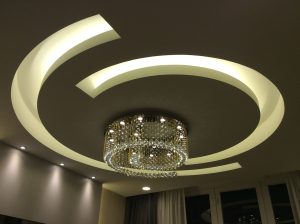Introduction
The false ceiling design of a main hall is an important aspect of interior design. It not only enhances the aesthetic appeal of the room but also serves functional purposes such as improving acoustics, hiding electrical and mechanical installations, and improving energy efficiency. In this article, we will explore innovative and impressive ideas for main hall false ceiling design.
Functionality
Before delving into the design aspects, it is essential to understand the functionality of the false ceiling. False ceilings offer several benefits such as:
Improved Acoustics
An open hall with a high ceiling can cause echoes and reverberations. False ceilings help in improving acoustics by absorbing the sound waves and reducing echoes. The use of acoustic materials such as mineral wool or fiberglass panels enhances sound absorption.
Concealment of Electrical and Mechanical Installations
False ceilings are an excellent way to conceal electrical and mechanical installations such as wiring and ductwork. This creates a clean and streamlined look.
Energy Efficiency
False ceilings help in improving energy efficiency by reducing the height of the room, which means less space is to be cooled or heated.
Designs
Gypsum False Ceiling
Gypsum false ceilings are the most popular choice for main hall designs as they are versatile and offer several design options. They are available in different finishes such as plain, textured, or patterned. They can also be combined with lighting options such as spotlights, cove lighting or pendant lighting which further enhances the design appeal.
Wooden False Ceiling
Wooden false ceilings add warmth and texture to a main hall. They can be in the form of a continuous wood panel or wood beams. Wooden false ceilings work well with different interior styles such as contemporary, traditional or rustic.
Decorative Plaster False Ceiling
Decorative plaster false ceilings are becoming increasingly popular due to their intricate designs and patterns. They are created using a variety of techniques such as stucco, sculpting, or molding. They can also be paired with different lighting options to create a dramatic effect.
Colour Schemes
Monochromatic Colour Scheme
A monochromatic colour scheme uses different shades and tones of the same colour. It creates a cohesive and polished look. For example, a white gypsum false ceiling paired with white walls and flooring.
Contrasting Colour Scheme
A contrasting colour scheme uses two opposite colours on the colour wheel such as black and white or blue and orange. It creates a bold and dramatic look. For example, a wooden false ceiling paired with blue walls.
Complementary Colour Scheme
A complementary colour scheme uses colours opposite each other on the colour wheel such as green and red or purple and yellow. It creates a vibrant and energetic look. For example, a decorative plaster false ceiling in purple paired with yellow walls.
Conclusion
Main hall false ceiling design is an essential aspect of interior design. It not only enhances the visual appeal of the room but also has functional benefits such as improved acoustics, concealment of electrical and mechanical installations, and energy efficiency. The use of innovative and impressive ideas such as gypsum false ceilings, wooden false ceilings, and decorative plaster false ceilings, coupled with different colour schemes, can create a visually stunning main hall.




More Posts
Stunning Vintage Opaline Lights: Illuminating Homes with Timeless Elegance
Bringing Versatility to Light: Exploring the Benefits of Dual Light Technology
Shining Light on E14 Bulbs: The Ultimate Guide to Understanding and Using Them